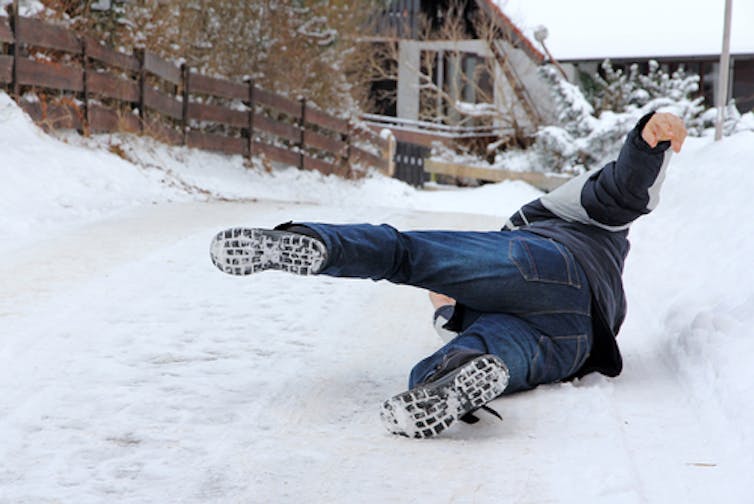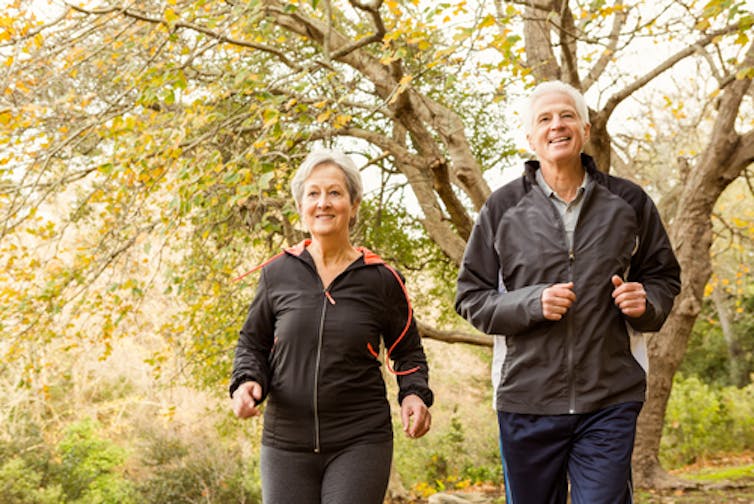Before the fall: How oldsters can avoid one of old age's most dangerous events
- Written by Matthew Lee Smith, Co-Director of Texas A&M Center for Population Health and Aging, Texas A&M University
Baby boomers, who once viewed themselves as the coolest generation in history, are now turning their thoughts away from such things as partying and touring alongside rock bands to how to they can stay healthy as they age. And, one of the most important parts of healthy aging is avoiding a fall, the number one cause of accidental death among people 65 and older.
The issue is growing more pressing each day. More adults than ever – 46 million – are 65 and older, and their numbers are increasing rapidly[1].
The Centers for Disease Control and Prevention estimates that one in four older adults will fall each year[2]. Falls are the leading cause of injury and injury deaths[3] among older adults. And, they are costly. Falls are responsible for an estimated US$31 billion in annual Medicare costs[4]. This estimate does not account for non-direct medical or societal costs.
People who fall can lose their physical mobility for life, go into a hospital never to be discharged, require skilled nursing or other caregiver support, or become so fearful about falling again that they dramatically limit their daily activities.
The good news is that most falls are preventable, research has identified many modifiable risk factors for falls, and older adults can empower themselves to reduce their falls risks. This means there are opportunities to intervene in clinical and community settings to promote protective behaviors and improve safety[5].
A life-changing event
Falls can cause fractures, traumatic brain injuries and other conditions that require an emergency room visit or hospitalization. An older adult dies from a fall every 19 minutes[6], and every 11 seconds an older adult is treated in an emergency room for a fall-related injury. About one in four falls results in needed medical attention, and falls are responsible for about 95 percent[7] of all hip fractures. In addition to the physical and mental trauma associated with the fall itself, falls often result[8] in fear of falling, reduced quality of life, loss of independence and social isolation.
 shutterstock.
Astrid Gast/Shutterstock.com[9]
shutterstock.
Astrid Gast/Shutterstock.com[9]
There is no single cause[10] for falling. Falls can result from issues related to biological aging, such as balance problems, loss of muscle strength, changes in vision, arthritis or diabetes. Taking a combination of several prescription drugs can also contribute to falls. Lifestyle behaviors such as physical inactivity, poor nutrition and poor sleep quality can also increase the risk for falling. Environmental hazards inside the home, such as poor lighting and throw rugs, and outside, such as bad weather, standing water and uneven sidewalks, can create situations where falls are more likely to occur.
It takes a careful village
Because falls can be caused by many things, the solutions must also include a diverse set of systems, organizations and professionals. Toward that end, 42 active or developing state fall prevention coalitions[11], which coordinate initiatives and serve as advocates for policy development and community action[12], are in place. Their activities foster collaboration across the aging services network, public health and health care system. They do such things as host health fairs and fall risk screening events, fall prevention programs, and awareness-raising events to inform decision-makers and legislators about ways to make communities safer for older adults.
Here are some of the key objectives that the coalitions are working on to reduce hazards from falling:
- Enhance clinical-community collaboration for programming.
There are many fall prevention programs[13] offered in communities to promote healthful behaviors and to reinforce positive mental perspectives about falls being preventable.
People concerned about falling should contact their local Area Agency on Aging[14] to find out where these programs are offered and which can be most beneficial. Also, seniors should ask their doctors about fall-related risk factors and what they can do to reduce risk. Communicate your concerns about falls with your health care team and social network, tell them about what you learn during your fall prevention programs, and report back about how they are making a difference in your life.
- Manage chronic conditions.
About 70 percent of older adults have one or more chronic conditions[15], many of which can increase the risk for falling. For example, people with diabetes may have vision problems and problems with sensation in their feet. Also, the medications used to treat these conditions can increase fall risk. And, taking five or more medications[16] has been identified with increased frailty and higher risk for falling.
 Being physically active can help seniors have better balance and reduce the risk of falls.
wavebreakmedia/Shutterstock.com[17]
Being physically active can help seniors have better balance and reduce the risk of falls.
wavebreakmedia/Shutterstock.com[17]
While health care access and utilization are important for chronic disease diagnosis and management, 90 percent of health care happens outside the health care setting. Therefore, older adults need to manage their diseases better. To do this, however, they often need help. For starters, they should discuss the side effects of all medications with their doctors and also how best to adhere to prescribed treatment regimens, such as when to take medications, whether to take with food and whether there are possible interactions of one medication with another. Seniors also can consider enrolling in evidence-based disease self-management programs[18] to improve their knowledge and confidence to manage their conditions as well as enhance lasting skills for goal setting and action planning, such as being physically active for 30 minutes a day for five days a week.
- Alter the physical environment.
About 44 percent of falls occur inside the home[19]. In-home risk factors for falls can include dim lighting, clutter on floors, throw rugs and ottomans, missing railings, uncovered wires and extension cords, children and pets underfoot and unsafe bathrooms. A unsafe bathroom is one with an inappropriate toilet height, high shower or bathtub walls and no grab rails.
To identify possible risks in the home, the CDC created a user-friendly safety checklist[20] that can safeguard older adults by eliminating environmental hazards.
- Maintain healthful behaviors.
Daily lifestyle behaviors such as physical activity, nutrition and sleep quality can influence fall risk, and these are never too late to change. Interventions can be successful for people of all ages. Among the most important is physical activity, namely safely performing lower-body exercises to increase strength, balance and flexibility. Additionally, seniors should work with their health care team[21] to have medications reviewed and eyes checked regularly. Also, they should ask about their vitamin D levels and possible nutritional supplementation.
References
- ^ increasing rapidly (www.census.gov)
- ^ one in four older adults will fall each year (www.cdc.gov)
- ^ leading cause of injury and injury deaths (www.cdc.gov)
- ^ US$31 billion in annual Medicare costs (www.sciencedirect.com)
- ^ promote protective behaviors and improve safety (www.frontiersin.org)
- ^ dies from a fall every 19 minutes (www.aging.com)
- ^ 95 percent (www.bmj.com)
- ^ falls often result (jamanetwork.com)
- ^ Astrid Gast/Shutterstock.com (www.shutterstock.com)
- ^ no single cause (www.cdc.gov)
- ^ state fall prevention coalitions (www.ncoa.org)
- ^ advocates for policy development and community action (www.ncbi.nlm.nih.gov)
- ^ fall prevention programs (www.ncoa.org)
- ^ Area Agency on Aging (www.n4a.org)
- ^ 70 percent of older adults have one or more chronic conditions (www.cdc.gov)
- ^ five or more medications (www.sciencedaily.com)
- ^ wavebreakmedia/Shutterstock.com (www.shutterstock.com)
- ^ evidence-based disease self-management programs (www.selfmanagementresource.com)
- ^ 44 percent of falls occur inside the home (www.who.int)
- ^ safety checklist (www.cdc.gov)
- ^ work with their health care team (www.cdc.gov)
Authors: Matthew Lee Smith, Co-Director of Texas A&M Center for Population Health and Aging, Texas A&M University

